|
The Society
Historical Information
Photo & Map Collections
Exploring Brookline
Links
Program Archives
|
Photo Collection
 |
Lower Washington St. At Entrance to Walnut St.
Brookline House, 108 Washington St., an eating establishment and boarding house started by Aaron Whitney circa 1865 and closed circa 1874. Comstock, Gove & Co. is making a delivery. A Boston firm, they bottled soda water and eventually expanded to making liquor.
|
 |
Lower Washington St. at Walnut St.
Looking east with Walnut St. coming in from the right. Partial view of the Brookline House, 108 Washington St., an eating establishment and boarding house started by Aaron Whitney circa 1865 and closed circa 1874.
Photo from the Brookline Chronicle, July 8, 1943
|
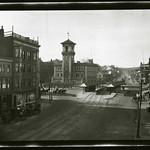 |
Lower Washington St., December 23, 1915
Looking west. Foreground left: W.P. Whittemore Co., Hay and Grain, 92 Washington St.; Roeder's Lunch Dairy, in the corner building, 104 Washington St.
[Source: Olmsted]
|
 |
Lower Washington St.
[Source: Brookline Preservation Department]
|
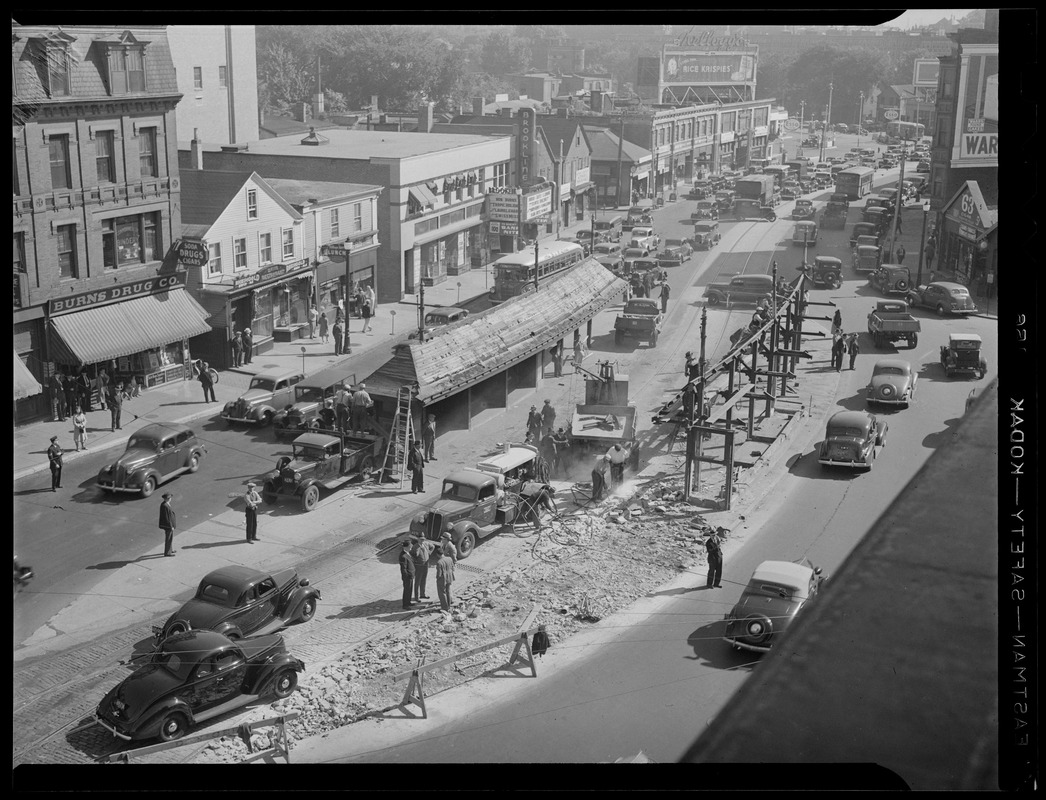 |
Brookline Village, September, 1938
The two films on the marquee played at the New Brookline Theater from September 8-10. In the distance, a bus prepares to turn right from Brookline Ave. onto Lower Washington St. In an effort to reduce the heavy traffic congestion in the Village, it had recently been decided to substitute busses for the trolleys on the Allston-Dudley route. The trolley transfer stations are being removed. None of the buildings in the photo still stand.
[Source: Digital Commonwealth]
|
 |
Lower Washington St., 1956
From left to right:
- 137 Washington St., Davis Restaurant
- 131 Washington St., Sagamore Liquors
- 127 Washington St., Hughes Pharmacy
- 123/123 Washington St.
- 115/117 Washington St.
- 105-113 Washington St. block including Brookline Village Shoe Store at #109, Mutual Auto School at #107, and the now-closed movie theater
- 103 Washington St., partial view of the White Tower restaurant
[Source: Digital Commonwealth]
|
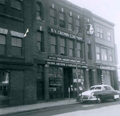 |
92-100 Washington St.
The final building at 104-108 Washington St. has recently been demolished and replaced by a gas station (off photo)
[Source: Brookline Preservation Department]
|
 |
Lower Washington St., circa 1875
Start of Boylston St. to the right going west; lower Washington St. toward Boston to the left. The structures to the left of the fire station were collectively known as “White’s Block”. On the far left on the corner with Walnut St. is a boarding house. In the middle is the sign for Thomas Mayo & Co. which sold furnaces, stoves, and kitchen goods. Immediately to the left of the station is the store of Frederick Sigwart, Cigars.
In the early 1870s the town was progressing to an organized fire-fighting system after years of more haphazard efforts. It created a Fire Department Board of Engineers. It funded this brick building, constructed at significant cost, that was completed in January 1872. In these early years fire houses were designated according to the piece of equipment they hosted. On the left is the Good Intent Hose Company (the hose wagon is pictured in front) which was organized in 1865 and disbanded May 11, 1875. On the right is the Thomas Parsons Steam Fire Engine.
From stereoscope. "Engine and Hose House, Brookline. E.R. Hills, Photographer, Brookline Mass.” Gift of Natick Historical Society.
|
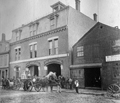 |
Lower Washington St., circa 1875
Start of Boylston St. to the right going west; lower Washington St. toward Boston to the left. The structures to the left of the fire station were collectively known as “White’s Block”. To the right is the shop of Royal Woodward, Blacksmith.
In the early 1870s the town was progressing to an organized fire-fighting system after years of more haphazard efforts. It created a Fire Department Board of Engineers. It funded this brick building, constructed at significant cost, that was completed in January 1872. In these early years fire houses were designated according to the piece of equipment they hosted. On the left is the Good Intent Hose Company which was organized in 1865 and disbanded May 11, 1875. On the right is the Thomas Parsons Steam Fire Engine (the steam wagon is pictured in front).
[Source: Brookline Public Library]
|
 |
Hose House #1, Brookline Village, 1891
Decorated, in a deliberately macabre fashion, for the annual Horribles Parade, 7/4/1891, for which it won the best-decorated building town prize.
|
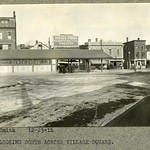 |
Washington St., North Side, December 23, 1915
Background buildings, left to right: Carl Astrom, photographer, #129; upper window of George Rozantes, fruit stand, #121; #115; Lyceum Hall Pharmacy, #113; Mack's Café, #107; David Lynch residence, small brick building, #105; Arthur Caulfield, insurance and real estate, #103.
[Source: Olmsted]
|
 |
Fire Station #1, Brookline Village, circa 1908
Washington St. in foreground coming from Huntington Ave. Boston, looking west to Boylston St. Hose House #1 and adjacent buildings torn down. New station completed in 1908 and is still in use today.
|
 |
Fire Station #1, Brookline Village, 1909
Trolley station not yet evident.
From postcard mailed October 8, 1909 by Katie, 150 Cypress St. Brookline
|
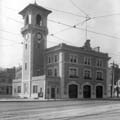 |
Fire Station #1, Brookline Village, 1909
|
 |
Brookline Village, circa 1909
The new fire station, just completed in 1908, is partially visible on the left followed by M. W. Quinlan’s carriage shop. Visible on the right are John H. Shea, Horse Shoer at 21 Boylston St.; J. O'Day, Stables at 19 Boylston St.; Crawford O' Hart, Tinsmith and Coleman and Horton, Cigars at 11 Boylston St.
The trolley car is from the Boston and Worcester Street Railway Co. The route started at Park Sq. sharing standard trolley tracks then switched to its own B & W tracks at an interchange just west of Chestnut Hill. The route continued to Worcester and the cars could travel at 60 mph once outside the local Boston environs. The telescoped photo obscures the fact that these cars were longer than the local trolley cars running in Brookline.
|
 |
Village Square, 1912
Looking east at Lower Washington St. from Boylston St. From left to right:
- 160 Washington St.: Guild Building. at the corner. This side of the building would soon be removed for the widening of Boylston Street.
- 7 – 11 Boylston St., under construction. The demolition permit for the existing building (9-11 Boylston St.), affected by the incipient widening of Boylston Street, was granted in July, 1912; construction was completed by the end of the year; and a new address, #7, was added.
- 7 Boylston St.. After many years at 157 Washington St., hairdresser Martin Geier is about to move his business here.
- 5 Boylston St., the fading sign for the grocery store of Francis H. Bacon remains but the business was taken over by Thomas McMahon a number of years ago.
- 166 Washington St., upstairs in the Guild Building. Signs for Forster Bros., Upholsterers and
The Brookline Print (Wallace B. Conant and Carl A. Smith), job printers, are visible.
- 157 Washington St., in the distance, the sign for Brookline Provisions is visible.
[Source: Brookline Preservation Department]
|
 |
Fire Station #1, Brookline Village, circa 1910
Trolley station erected. Small bushes planted on side of station.
|
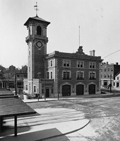 |
Fire Station #1, Brookline Village, circa 1910
From left to right:
- 32 Allerton St., rear, high on the hill (still standing)
- 34 Walnut St., Edward J. Kirker, Real Estate; Brookline Press
- 38 Walnut St.: Mark Bergstein, Tailor
- 40 Walnut St.: Eagle Hand Laundry
- The fire station. Note underground toilets to the left.
- 1 High St.: Michael W. Quinlan, Carriage Mfg.
- 9 High St., brick apartment building, partial view
[Source: Brookline Preservation Department]
|
 |
Fire Station #1, Brookline Village, 1910
The 1909 Knox chemical and hose wagon, the first motorized fire-fighting vehicle purchased by the town. It was known as "Combination A" and ushered in the end of the horse-drawn era. Pictured are:
- George Murray, driver
- John Allen, Assistant Chief, next to the driver
- John O’Neil, rear, first on the left
- Two unidentified men, rear left
- Lt. Frank T. Pons, Sr., at the back
- Lt. Frank Hayes, Sr., rear right
[ref. The Brookline Chronicle, August 22, 1968, pg. 1]
|
 |
167 and 163 Washington St.
This photo was taken prior to the leveling of the block for the Hearthstone Plaza and the leveling of the entire area then known as “The Marsh”. The business of the Brookline Bulk Candy was deemed by the Brookline Redevelopment Authority to be neighborhood-specific and was relocated across the street at 216 Washington St. By contrast, the Ames Supply Co., partially viewed on the left, was not given an option to relocated nearby.
From a notebook of property-appraisal photos taken in 1965 and early 1966 for “The Marsh Urban Renewal Project” run by the Brookline Redevelopment Authority. Only a few scattered peripheral structures remain today.
|
|